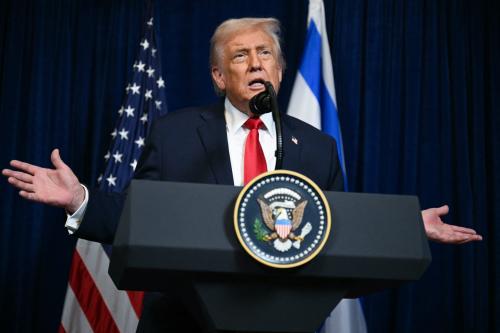As the president prepares for his rescheduled Asia trip on April 23-27, events in Ukraine continue to unfold in a dangerous way. The president’s policy in Ukraine has been met with a concern about what it reveals about U.S. power, perceived U.S. retreat and the fraught question of U.S. leadership. Do Japan and Korea and the other Asian powers view U.S. reactions in Ukraine as signifying a weakening of U.S. commitment to its leadership role? Will the president succeed in implementing his vaunted “pivot to Asia”? How can the U.S. balance the pivot to Asia with ongoing commitments in Europe, to say nothing of the Middle East?
Here are some factors to consider:
Do events in Ukraine cause Japan and the Republic of Korea to worry about U.S. defense commitments?
Here’s the difference: Japan and Korea are allies; Ukraine is not. Some critics have contended that the perceived limits of the U.S. response to Russian actions in Ukraine will leave allies questioning America’s willingness to live up to its commitment. But Ukraine is not an ally; there are limits to the scale and nature of the U.S. commitment there. The U.S. response to challenges in Asia has been more emphatic. When China unilaterally established an Air Defense Identification Zone (ADIZ) in November 2013, covering much of the East China Sea and implicitly threatening Japanese possessions there, the U.S. response was swift and firm: the U.S. secretary of defense made a strong statement clarifying that the Japanese-administered Senkaku Islands (whose status is disputed by China) falls under the U.S. alliance commitment to Japan, and flew two B-52 bombers through the Chinese ADIZ. China did not respond, and the situation did not escalate. One conclusion that can be drawn from the difference between the U.S. response in the East China Sea and in Ukraine: far from undermining the sense of U.S. commitment to its allies, the differences between these episodes should actually reinforce the incentives to strengthen alliances with the United States. In short: it’s good to be an ally.
Can the U.S. still “pivot to Asia”?
Yes – but the president and his team have to do a better job at communicating what that means. In fairness, when the policy was first announced, no one in the White House used the term “pivot”: the concept was a “rebalance” of the U.S. force structure from its high-level commitments during the wars in Iraq and Afghanistan to a more balanced global presence, including an increase in both the military and diplomatic presence in Asia. Events in Ukraine don’t change or challenge that in fundamental ways. But the phrase ‘pivot’ has drawbacks: we’ve convinced everyone in the Middle East that we’re leaving, no one in Asia that we’re coming and everyone in Europe is confused as to where we’re going. The president should abandon the phrase “pivot” and start talking about a “balanced” foreign policy and a balanced global presence. Meanwhile, the pivot is already starting to happen – through expansion of base facilities, through an expansion of diplomatic presence, with the Marines base in Australia. The president has made it clear to the White House staff that he expects to continue to focus on an increased presence in Asia through to the end of his term.
Does a focus on Asia mean doing less globally?
It might. I’ve been a critic of U.S. policy in Syria, but I have to concede that none of our Asian allies wanted to see us get entangled in yet another complex war in the Middle East. Quite a different issue is our security role in the Gulf. All of the Asian powers – Japan, Korea, China, India – rely on the U.S. continuing to play a role in forestalling inter-state war in the Gulf. That’s necessary for the stable flow of oil, and all the Asian powers are dependent on that flow for their economies. None more so than China, whose role in the region is the real issue at the heart of this trip.
Is the trip about trying to contain China?
American foreign policy commentary tends to fall into binary options: we can submit to China’s inexorable rise, or try to contain it; we have a ‘win-win’ relationship with China, or we’re facing an inevitable conflict – as often happens when one power rises and another falls. All of this is hugely over-simplified. For these reasons:
- The U.S. is an enduring, not a falling power;
- China is a rising power, but faces numerous complications – and most of them are internal.
- China and the U.S. are heavily integrated, financially and in trade terms – that limits the incentive for conflict.
- China is increasingly dependent on energy imports to keep its economy growing – and it can’t secure those imports without cooperation with the U.S. and the West; that sharply limits China’s options.
- China and the U.S. are all-but certain to be competitors; but that’s a long way from Cold warriors.
So the right policy for the U.S. is neither to blithely accept China’s more aggressive demands, nor to attempt a full-on containment strategy. Rather, U.S. policy has to focus on shaping the environment in which China rises, both in Asia and globally. The TPP trade negotiations are a big part of this, and that will be an essential focus of this trip. And this does link Asia with Ukraine – in both cases, more than U.S. military power is in play (though that is clearly in play too): it’s also America’s market, financial and “coalitional” power that are key to success.
Will all of this satisfy our Asian allies?
Of course not. If there’s any constant in U.S. alliance management, it’s that allies are never satisfied. But the trip will allow the president to put a focus on continued “rebalancing” activity; to push forward the TPP trade negotiations; and to privately and publicly signal that the U.S. remains committed to its Asian allies. Meanwhile Vice President Biden will travel to Ukraine to keep a U.S. focus on events there.
What can we conclude from all this?
Now and for the foreseeable future, the U.S. will be the most influential global power. But it’s going to be tested by all comers. China has strong, powerful incentives to continue to cooperate with the U.S., but there are incentives for rivalry as well, especially in the East and South China Seas. Russia has fewer incentives for restraint and may pose the sharper challenge in the next few years. The Gulf will continue to matter to America’s global role, and turbulence there will compel American responses. In every region at every turn, the U.S. will be accused of doing too little – and sometimes, like in Syria, that criticism will be right. But the lodestar of U.S. foreign policy must be maintaining its alliances, and broadening its coalitions, to extend its global capacity – what I call U.S. “coalitional power”. Only the U.S. is in a position to play that role.
The Brookings Institution is committed to quality, independence, and impact.
We are supported by a diverse array of funders. In line with our values and policies, each Brookings publication represents the sole views of its author(s).



Commentary
The President’s Trip to Asia: Ukraine and the Global Context
April 23, 2014